Section II - Performance Tests, Synthetic -
In this section of testing we cover the synthetics. These are tests that run a scripted sequence of internal APIs or that use another installed application to perform a series of scripted events. They are great in that they can provide reproducible results across various platforms. On the down side, synthetic tests can be fooled with driver tweaks and optimizations. In some cases it is necessary to rename the .exe file to something generic to discover if this is the case. In any event when this is needed (when a test shows a drastic difference in performance over the renamed exe) we will note this and show both results for comparison.
PCMark Vantage -
PCMark Vantage is a suite of tests designed to test the power of your computer. It runs task that range from productivity to gaming (DX9 only). It is a great test to identify potential problem areas with general performance on a system. It can also show how well a single component can increase or decrease system-wide performance. We run both the x86 and x64 PCMark Suites for testing.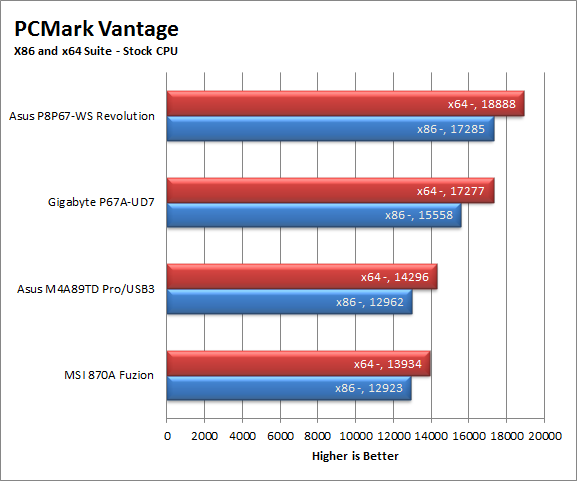
Even at stock speeds the scores are impressive. This test would seem to indicate that the WS is a great board for general computing. Of course we would never ask you to rely upon just a synthetic test so while this is a good sign, we will have to wait and see what else the WS Revolution can do.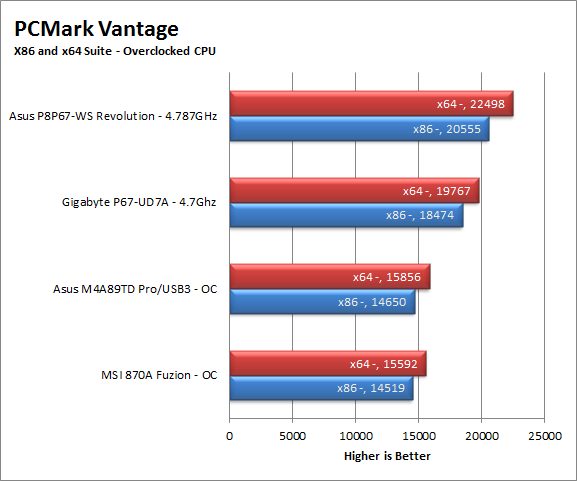
The overclocked scores are just plain sick; it really shows you what you get from Sandy Bridge on a good platform.
3DMark 11 -
3DMark 11 is the other FutureMark test that we run on our motherboards. This test simulates the typical tasks that a GPU (and system) would have to perform to provide you with a good gaming experience. It is based on the DX9, 10 and 11 engines but can only be run on systems that have DX11. The suite of tests covers rendering from all three APIs, AI computations and Physics; that is right there is no more proprietary PhysX to worry about. Instead FutureMark went with a traditional CPU bound Physics engine to put things one a more level playing field. 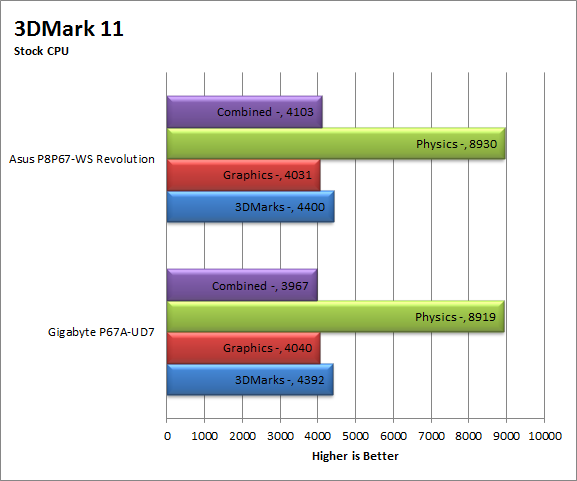
As FutureMark dials in closer to a real gaming experience we are seeing what our real-world gaming tests have shown. The CPU and Motherboard do not have a major impact on gaming performance. With that said it is also possible for someone to make a mistake in trace tuning, the Audio CODEC or even drivers that can cause issues with gaming performance. Thankfully the P8P67 WS Revolution has none of that. Once again, this test is only an indicator for gaming potential; it is not the final say on that, the indicator is good for now.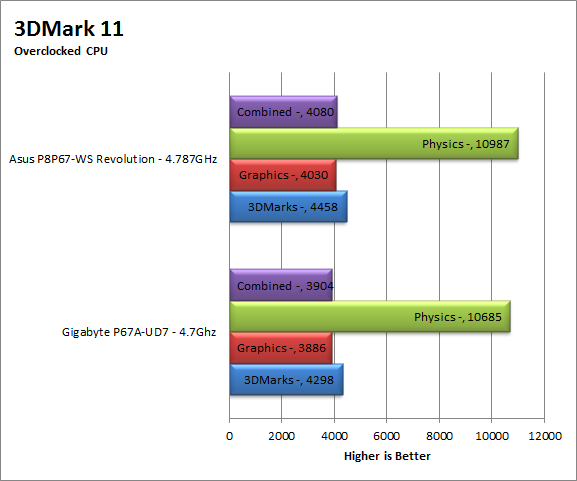
HyperPi 0.99b -
HyperPi is a front end application that allows you to easily run multiple instances of the SuperPi application. SuperPi, for those that are not familiar with it, is an application that measures the time it takes to calculate the number Pi out to as many as 32 million places. This calculation is then checked and run multiple times (up to 24 for a 32M run). This test stresses the CPU, Memory and HDD as data is handed off between the three. If there is a weak link, HyperPi will show it. For our testing we run the 32M test on as many cores (and threads) as the CPU has available. The slowest CPU time is then recorded. 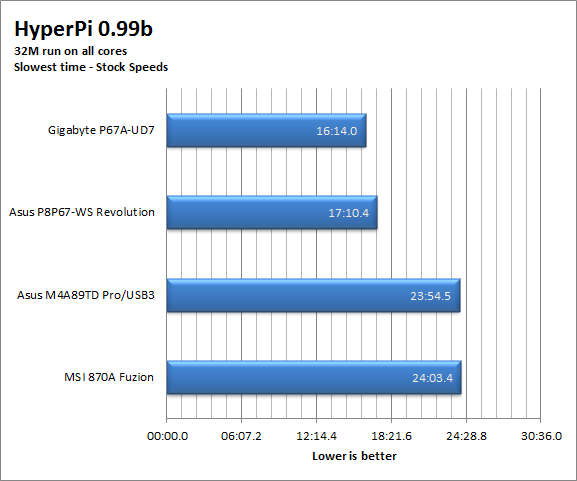
Under stock speeds the WS Revolution comes in almost a minute behind the leader. This is a little disappointing and was not expected based on the HDD and Memory performance we saw earlier. We ran this test more than our normal three runs but came up with similar times during each run.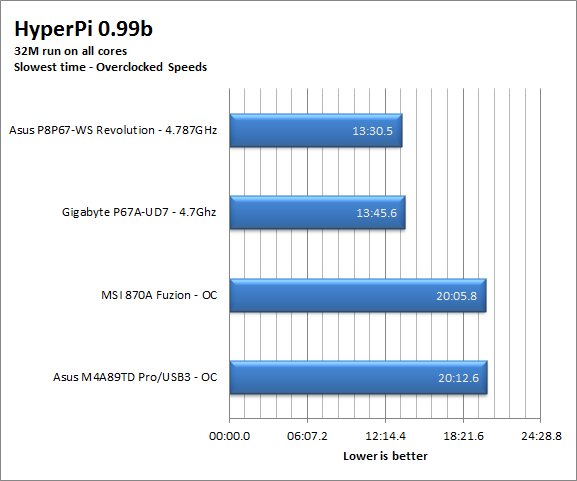
When overclocked the Asus WS Revolution kicks things back into place with a much better score. The Revolution comes in just over 15 seconds faster than the UD7.
Cinebench R11.5 -
Cinenbench R11.5 is the 11th release of Moxon’s rendering test. This test is based off of the Cinema 4D engine, which is one of the industry standard tools for digital animation. It is a powerful product with many different modules that can be “plugged” into it to increase its effectiveness. With Cinebench you get to see how your computer would do using this application. There are two tests; one tests the CPU’s ability to render an image across multiple cores or threads. The other tests your systems ability to handle OpenGL based rendering. 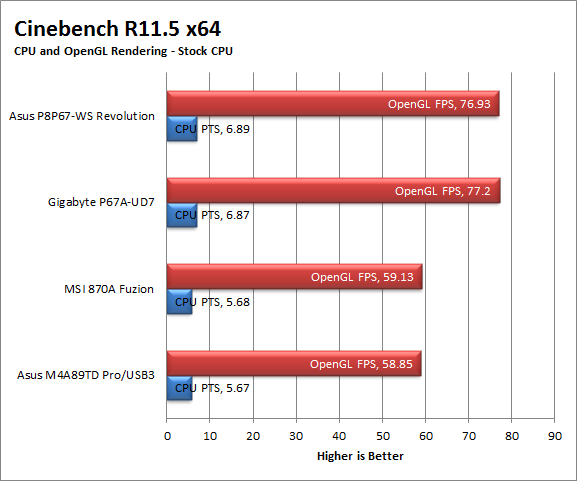
Once more the P8P67 WS Revolution shows an excellent level of performance with the Cinebench rendering test. This test lets us know that the WS Revolution really can handle professional software and the demands they place on a system even if it is only a synthetic test.
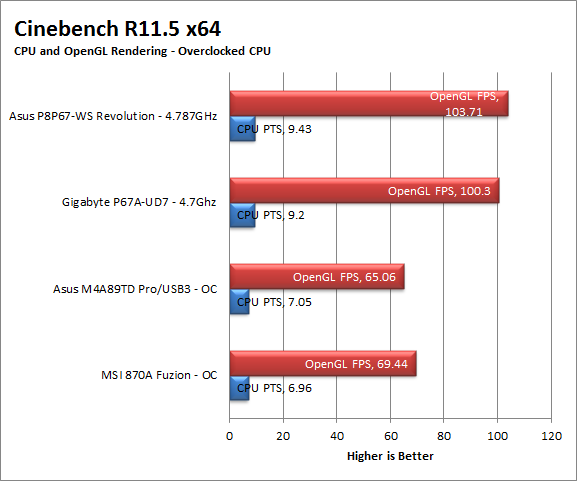

 For our second review of 2011 we thought we would take a look at a P67 board (despite all the drama). We chose the Asus P8P67 WS Revolution. This board (like you did not know) is part of Asus’ workstation line up, but that does not mean that it is boring. In fact the WS Revolution is anything but boring. It has been built with the professional enthusiast in mind. You get items like an NF200 chip to help support three way SLI and Crossfire, a 92% power efficiency rating, multiple SATA 3.0 ports (supported by Intel and Marvell), and dual Intel GBe LAN ports. But there is more to it than just the sum of its features. You also get an improved VRM (voltage regulation module), thicker traces for better signal transfer and quite a bit more. With all of this waiting to be tried out, let’s quit the intro chatter and dive into the P8P67 WS Revolution.
For our second review of 2011 we thought we would take a look at a P67 board (despite all the drama). We chose the Asus P8P67 WS Revolution. This board (like you did not know) is part of Asus’ workstation line up, but that does not mean that it is boring. In fact the WS Revolution is anything but boring. It has been built with the professional enthusiast in mind. You get items like an NF200 chip to help support three way SLI and Crossfire, a 92% power efficiency rating, multiple SATA 3.0 ports (supported by Intel and Marvell), and dual Intel GBe LAN ports. But there is more to it than just the sum of its features. You also get an improved VRM (voltage regulation module), thicker traces for better signal transfer and quite a bit more. With all of this waiting to be tried out, let’s quit the intro chatter and dive into the P8P67 WS Revolution.

